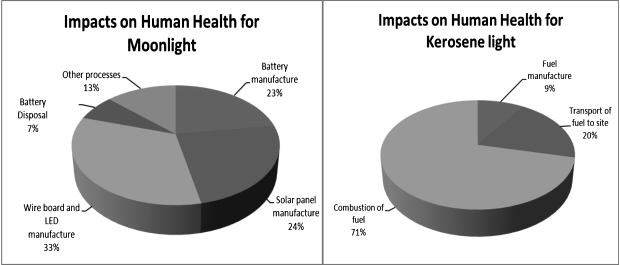B.3 Environmental Impacts and Discussion
Environmental impacts are assessed by using the ReCiPe 2008 impact assessment method's (Goedkoop et al., 2009) end points, which are damage to human health, damage to ecosystems, and depletion of resources.
The results in Figure B.3.1 show that the PV-lighting products generally have a lower environmental impact when compared to the other, “conventional” sources of light. The kerosene lamp is the most harmful to the environment on all categories considered. When the kerosene lamp is removed from the assessment, the relative differences between the other lighting systems become more visible. This is shown in Table B.3.1.
Table B.3.1 Life cycle impacts for lighting products, kerosene light excluded.

Figure B.3.1 Damage assessment using a ReCiPe impact assessment method, logarithmic scale

From Table B.3.1, it can be seen that the battery charged with a diesel generator has a larger impact than the other systems considered; however, the impacts from the light plus grid are comparable to those of the “worst” PV-lighting product (although still slightly higher).
It is interesting to see that the drivers of impacts are widely different between the “conventional” lighting solutions and the PV lights. Figure B.3.2 shows that Moonlight's impacts mainly originate from manufacturing processes, and to a lesser extent the disposal phase. However, impacts from the kerosene light are mainly fuel related, with the majority of emissions on site (when the product is used).
Figure B.3.2 Shares of impacts on human health. Left: The Moonlight. Right: The kerosene light. Note that the total impact of the Moonlight is a factor 100 less than that of a kerosene light

Although the results seem optimistic for the PV lights, there is reasonable uncertainty regarding some aspects of the inventory (Durlinger, Reinders, & Toxopeus, 2012). Some system components have a relatively large impact and large uncertainty (e.g., battery disposal and the printed circuit board), and therefore have to be researched in more detail. Especially worrying in that sense is the relatively high impact that Ni from NiCd batteries has on ecotoxicity. It is shown, in the sensitivity analysis, that a responsible handling of batteries will improve Moonlight's environmental profile. Due to poor data quality on batteries, it is impossible to recommend alternatives to the currently used NiCd batteries.
